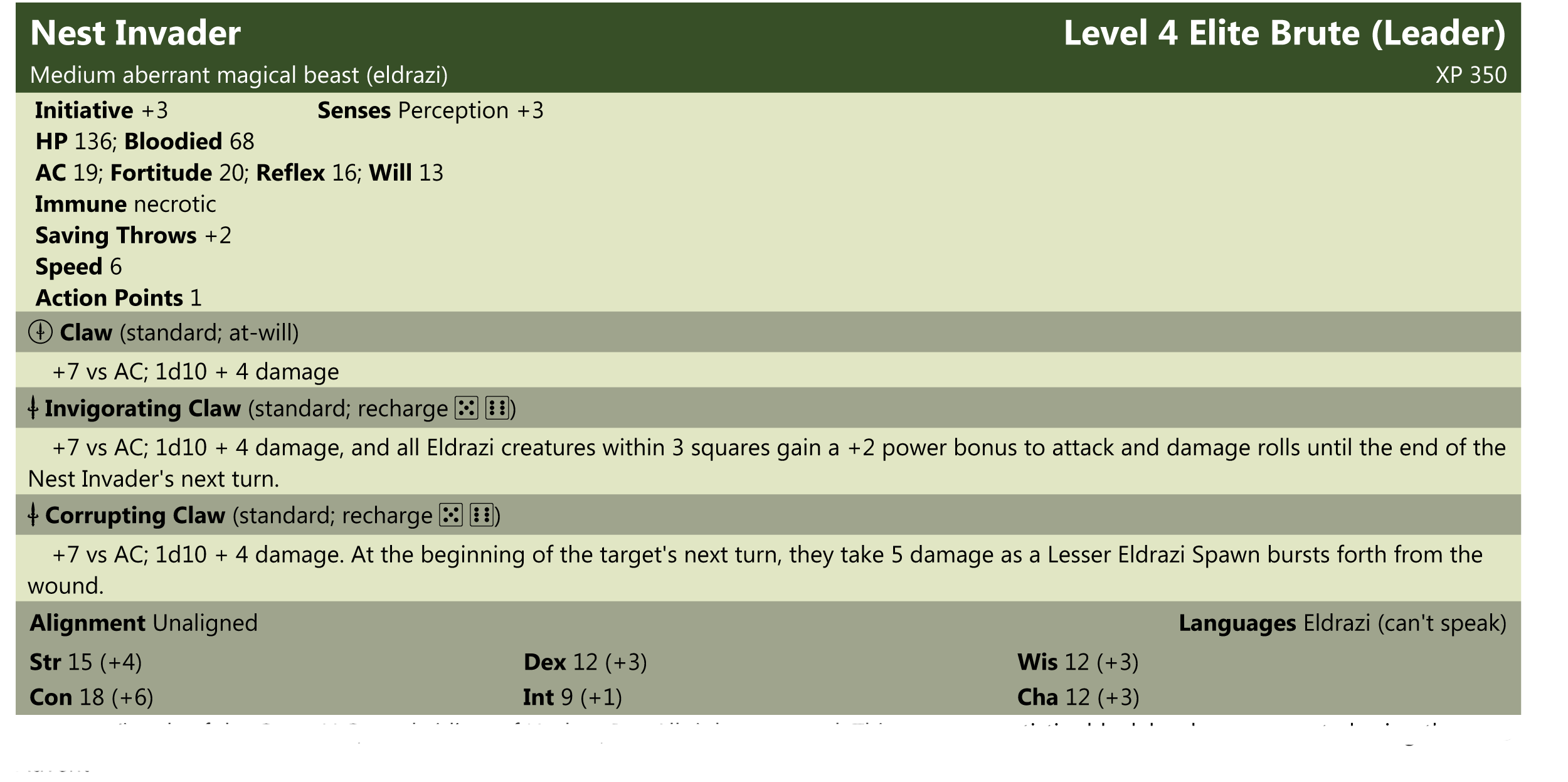Rising Stars, Part I
April 26th, 2010
Hello, everyone. Those of you who are big Magic: the Gathering fans will be well aware that the new set, Rise of the Eldrazi, launched over the weekend. Being an avid fan of Magic myself (my goal in life is to someday succeed Mark Rosewater, if you couldn’t tell from the column’s style), I eagerly attended the prerelease, two weekends ago (though only a couple of days ago at the time I’m writing this). While I was there, I got to thinking about some of the design strategies in the new set mechanics, and thought it might be fun to write an article examining what the designers were doing with cards in Rise and what lessons we can extrapolate into D&D design (or game design in general) from them. So, in a nutshell, that’s what I intend to do today.
Oh, and if you’re just here for the Eldrazi stats, they’re down below. You can either read through all my pretentious design talk, or just “Ctrl+F” and search for “Nest Invader.” Enjoy.
Now that that’s out of the way, let’s talk about levelers, shall we? Levelers are a new creature mechanic (though, in theory, there’s no reason it couldn’t be applied to enchantments, or even lands. That’d be something to see…) which, for an additional investment of mana at a later time, allows a player to permanently improve a level-up creature. For example, Knights of Cliffhaven begin life as a 2/2 for 1W (a white Grizzly Bears, basically) but, for four small payments of 3 mana, can become a Serra Angel.
Levellers in Rise of the Eldrazi have been touted as being far more effective than other weenie creatures (something my time at the prerelease certainly attests to) because they will quickly outstrip their contemporaries. As the game wears on, a 2/2 for two simply becomes outclassed and, in a lot of cases, frankly useless except as a warm body to fill a proverbial seat. Meanwhile, a level-up creature can, at least to an extent, continue to grow to meet the needs of the player.
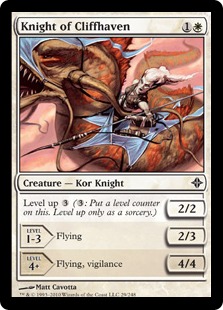
Ironically, even though levelers are based off of the mechanics of Dungeons and Dragons, I think that levelers actually have some design gold in them for D&D designers who look. You see, if there’s one thing that happens throughout the course of a D&D campaign, it’s an upward spiral in power levels. And as the stakes grow higher and higher (and the numbers exorbitant) players quickly find that a lot of things that were very useful before are entirely useless now, and being burdened with useless things is rarely a fun part of the game. The easiest example is copper pieces. Most players above 3rd level will never even consider picking up a pile of copper coins. But, as time wears on, the same attitude can eventually be applied to +1 weapons and armor. And, of course, numerous feats and class features become less and less important as time wears on, as do low-level spell slots.
In a lot of cases there’s nothing to be done about the matter. There are plenty of 1st level PCs who will never touch a copper coin, and if every goblin was carrying gear good enough to count as “treasure” the PCs would quickly be swimming in the stuff. At the same time, however, feats and equipment have room, I think, for improvement in this way. There are already some feats which improve automatically as you level up (in Pathfinder, at least, Skill Focus works this way, and I know that 4th edition has a wide variety of powers and at least a few feats which improve as characters move from tier to tier), and players like them because, in general, they remain more relevant as the game goes on, and don’t feel like dead weight around level 17. As for magical gear, of course you can further enchant it, but there’s rarely much point when you can scavenge magical loot for free. What I’d like to see is more magical weapon/armor/shield abilities which are dependent on the wielder’s level, rather than the crafter’s level. Pricing such items might prove difficult, but I’m sure someone will come up with something. Perhaps for Into the Armory 2: The Completer Guide to Weapons, Armor, and Equipment.
Another major theme in Rise of the Eldrazi is defenders. Defenders, for those of you who don’t play Magic, are creatures that can’t attack, but can still block opponent’s attacking creatures. Most of them are walls, if that helps you understand. Anyway, they’re a big part of Rise. Why? Well, to put it simply, to make sure that, at least in limited, games go long. Wizards designers wanted Rise to be a slow set, so that people would be able to actually cast those giant Eldrazi spells. Of course, here the designers faced a slight problem: players, generally speaking, don’t like defenders. They aren’t very fun. You can’t attack with them, and even the best wall is rarely insurmountable. Of course, players are perfectly happy to play with walls that also do something else, such as a wall that draws you a free card, or a wall that can tap for mana. And they’re even more happy to play with defenders if you print a lot of support cards, such as a card that makes all your defenders bigger, or a card that generates more mana if you have more defenders, or even a card that deals direct damage based on how many defenders you have. In short, Wizards bribed players to play with defenders in order to help ensure long games.
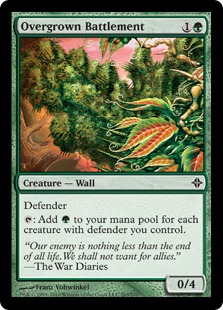
And it worked. Brilliantly. “Bribe” makes it sound ugly, but really what the designers at Wizards were doing is making defender creatures (in Rise of the Eldrazi, at least) more fun and viable to play with. It’s a core part of set design these days, and that’s part of what makes a Magic set function. Unfortunately, it doesn’t work nearly as well in Dungeons and Dragons. Don’t get me wrong, there’s plenty of “here’s a bunch of items/feats/spells/classes/alternate class features designed to make playing a (___________) more fun and viable” going on out there. After a fashion, you could say that that’s what Liber Vampyr was. The problem is that these supplements tend to be shortsighted. Magic designers can afford to take the short view when they design a set: their primary focus is on standard (i.e., only the set immediately before and immediately after a given set) and to a lesser extent extended (a much broader range, but still encompassing only a handful of sets at any given time). Worrying about any format that allows cards from all of Magic is foolish, because it would force them to either stop printing new cards or accept that every card they make (even the terrible ones no one would ever want to play with) is going to raise the power level of the game, if only a tiny fraction (I’ll discuss this in more detail in another article, I’m going to go long as it is). So, as far as they’re concerned, all those pro-defender cards will be gone a year from September.
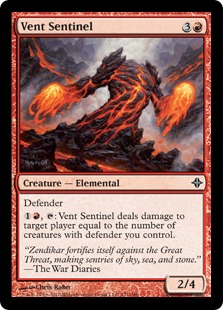
Dungeons and Dragons, on the other hand, does not have the luxury of a “standard.” Anything that ever sees print for Dungeons and Dragons is around forever. Which means that as time goes on and these “rewarding” items/feats/spells/etc pile up higher and higher, eventually it isn’t so much that players are being rewarded for playing something, but rather it feels like they’re being punished for not being a kobold paladin/sorcerer who specializes in fighting with, I don’t know, let’s say hand-crossbows. I’m not saying that bribing players to play certain things is necessarily a bad thing in D&D, I’m just saying that it has to be done carefully, because if you print something that’s too powerful in your quest to attract players’ attention, it will never go away. Personally, as a designer for D&D, I would much rather make underpowered things than overpowered ones, as long as they’re fun to play. Of course, properly-powered things are the goal, but that’s neither here nor there.
Join me next week, when I’ll finish talking about Rise of the Eldrazi’s game design from the perspective of a D&D designer. Until then, enjoy some Eldrazi stats, why don’t you?
Today I'm proud to be offering two Eldrazi stats, not only for Pathfinder but for 4th edition D&D as well. First up is the Nest Invader, pictured here:
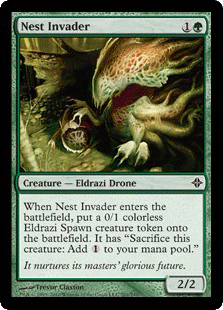
Nest Invader
This creature is wholly alien in appearance, and can be described only as “vaguely plantlike”. Its skin is a pale, sickly green, and its body is comprised mostly of tentacle-like growths. Its “head” appears to be a thick mass of matted veins.
Nest Invader (CR 3)
XP 800
N Medium aberration (eldrazi, extraplanar)
Init +1; Senses darkvision 60 ft., scent; Perception +7
DEFENSE
AC 18, touch 11, flat-footed 15 (+1 Dex, +7 natural)
hp 33 (4d8+15)
Fort +6, Ref +2, Will +1
Immune negative energy
OFFENSE
Speed 30 ft.
Melee 2 claws +5 (1d6+2 plus corrupting touch)
Special Attacks corrupting touch
STATISTICS
Str 15, Dex 13, Con 16, Int 2, Wis 10, Cha 6
Base Atk +3; CMB +5; CMD 16 (20 vs. trip)
Feats Toughness, Run
Skills Perception +7, Survival +7;
Languages Eldrazi (cannot speak)
SPECIAL ABILITIES
Corrupting Touch (Su): Any creature struck by a Nest Invader’s claw attack must succeed on a DC 12 Fortitude save or have their body warped by the Nest Invader’s otherworldly nature. Creatures who fail their initial save must make a DC 12 Fortitude save each day or take 1d4 points of Wisdom damage as their body and mind slowly warp and morph into an Eldrazi Spawn. A successful save does not prevent the transformation, only delay it (though a remove disease spell, or similar, can stop the effects of the corruption). If a creature’s Wisdom is reduced to 0 while under the effects of Corrupting Touch, the transformation is complete and they are permanently transformed into an Eldrazi spawn with no memory of their past life. Creatures transformed in this way can be restored only through a wish or miracle spell.
ECOLOGY
Environment any
Organization solitary, pair, or nest (1-4 plus 3d6 eldrazi spawn)
Treasure incidental
One of the weakest Eldrazi, but also one of most insidious, the Nest Invader infiltrates the dens of animals and magical beasts, using its corrupting touch to spread the taint of Eldrazi influence and increase the size of its brood.
Though the corrupting touch of the Nest Invader is practically a death sentence, the Nest Invader shows a curious protective streak towards any creature it has corrupted, protecting and doting over it until it “matures” into an Eldrazi spawn. It is not uncommon to find a Nest Invader carefully tending young bear or wolf cubs it has corrupted after slaying their mother.
Or in fourth edition terms...
